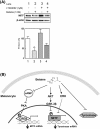Betaine reduces cellular melanin content via suppression of microphthalmia-associated transcription factor in B16-F1 murine melanocytes
- PMID: 30263674
- PMCID: PMC6049772
- DOI: 10.1007/s10068-017-0171-6
Betaine reduces cellular melanin content via suppression of microphthalmia-associated transcription factor in B16-F1 murine melanocytes
Abstract
Long-term topical skin care by traditional anti-melanogenic agents can raise several safety concerns. An understanding of the molecular mechanisms of active compounds on melanogenesis is, therefore, necessary to address pigmentation issues. Here we revealed that stimulation with 1 mM betaine, an abundant component in rice bran, significantly reduced 21% of intracellular melanin content by suppressing tyrosinase activity and microphthalmia-associated transcription factor (MITF) expression in B16-F1 murine melanocytes. The expression of MITF was suppressed at both mRNA and protein levels by 43 and 44%, respectively. Subsequently, the betaine-stimulated melanocytes showed inhibition of PKA-CREB signaling axis but activation of extracellular-signal-regulated kinase and AKT-GSK3β signaling pathways. This inhibition and activation led to downregulation of MITF expression at both the transcriptional and post-translational levels to suppress melanin synthesis. These findings collectively suggested that betaine is a potential anti-melanogenic compound for functional foods and cosmetics.
Keywords: Betaine; MITF; Melanocyte; Melanogenesis; Tyrosinase.
Conflict of interest statement
Compliance with ethical standardsThe authors declare no conflict of interest.
Figures




References
LinkOut - more resources
Full Text Sources
Other Literature Sources
